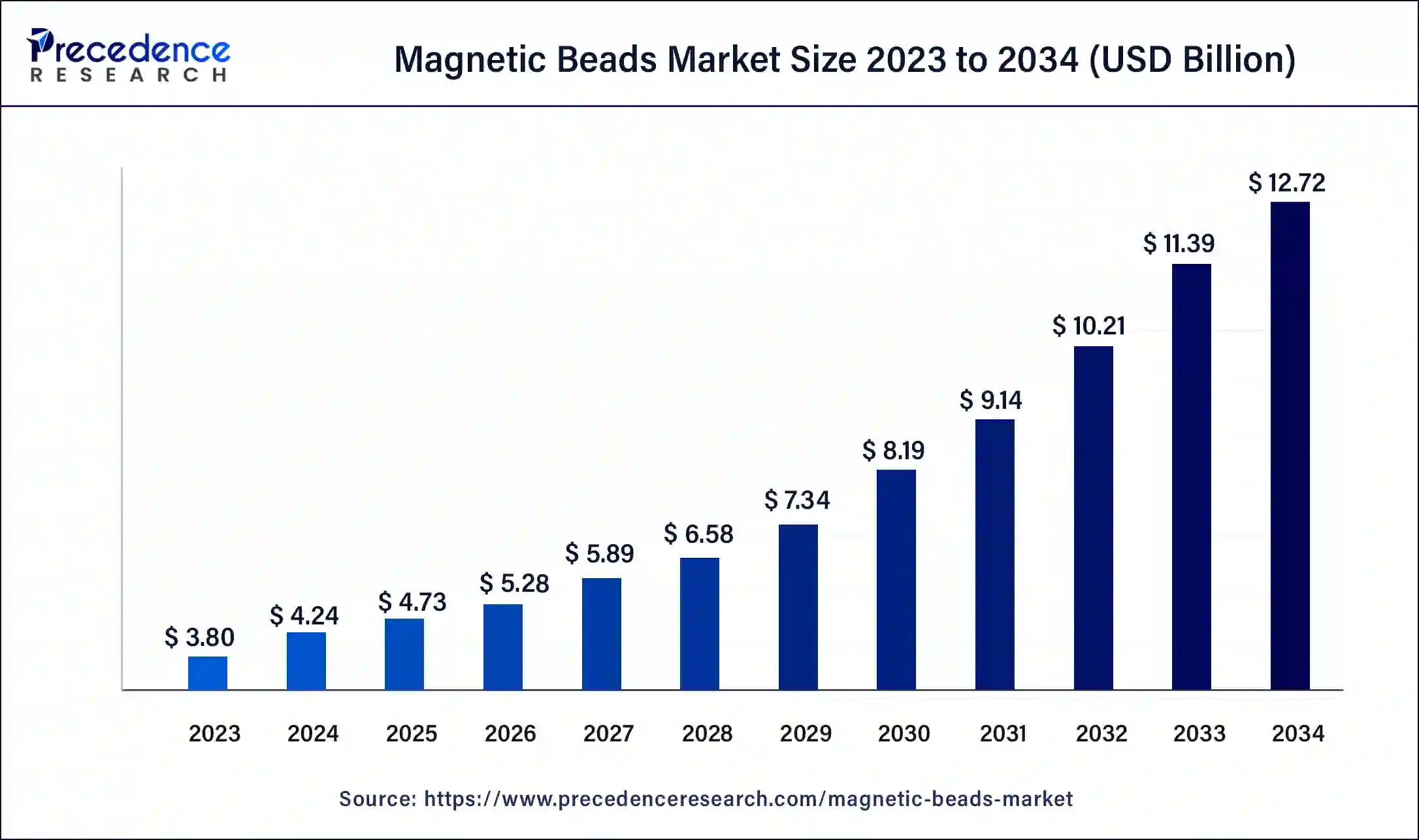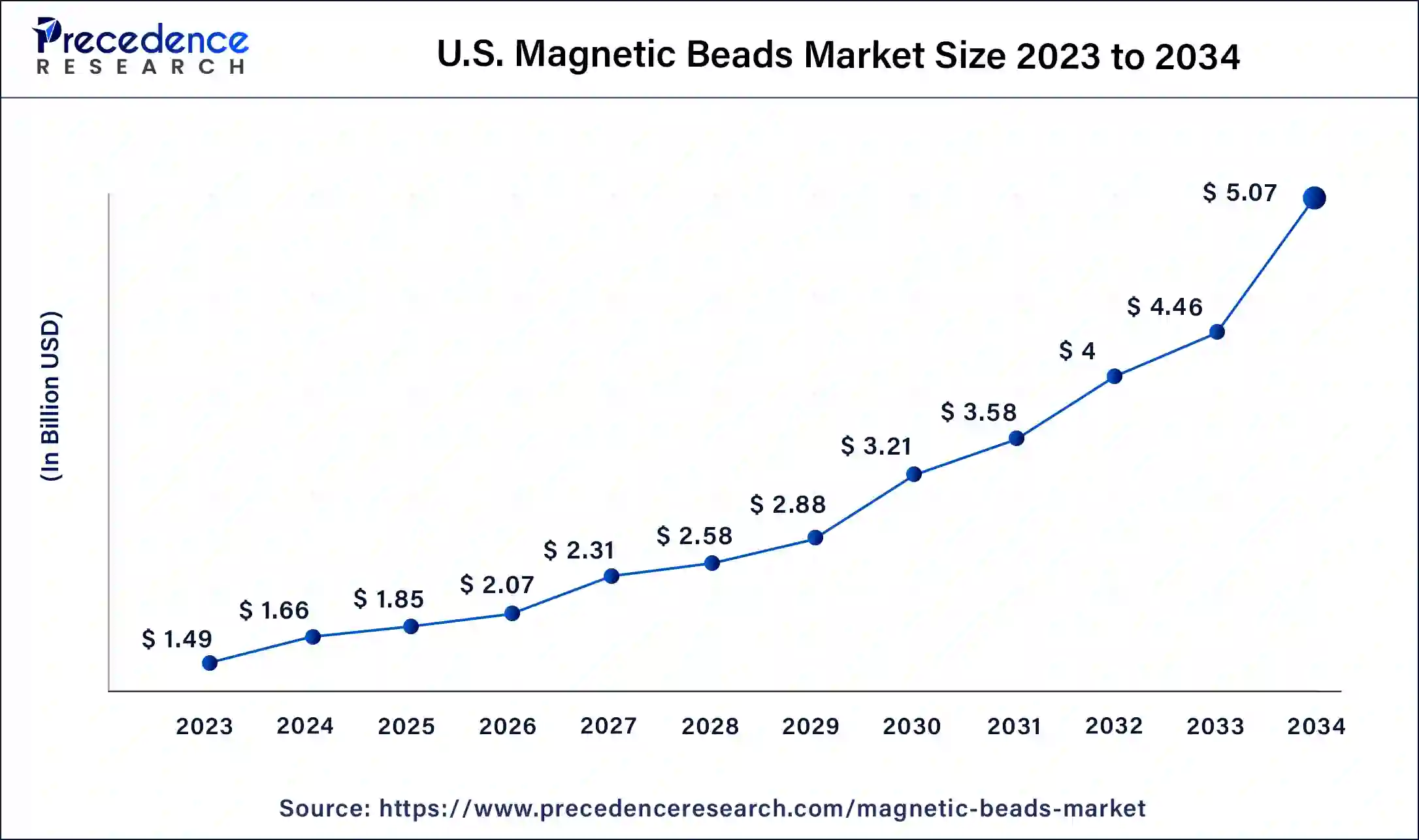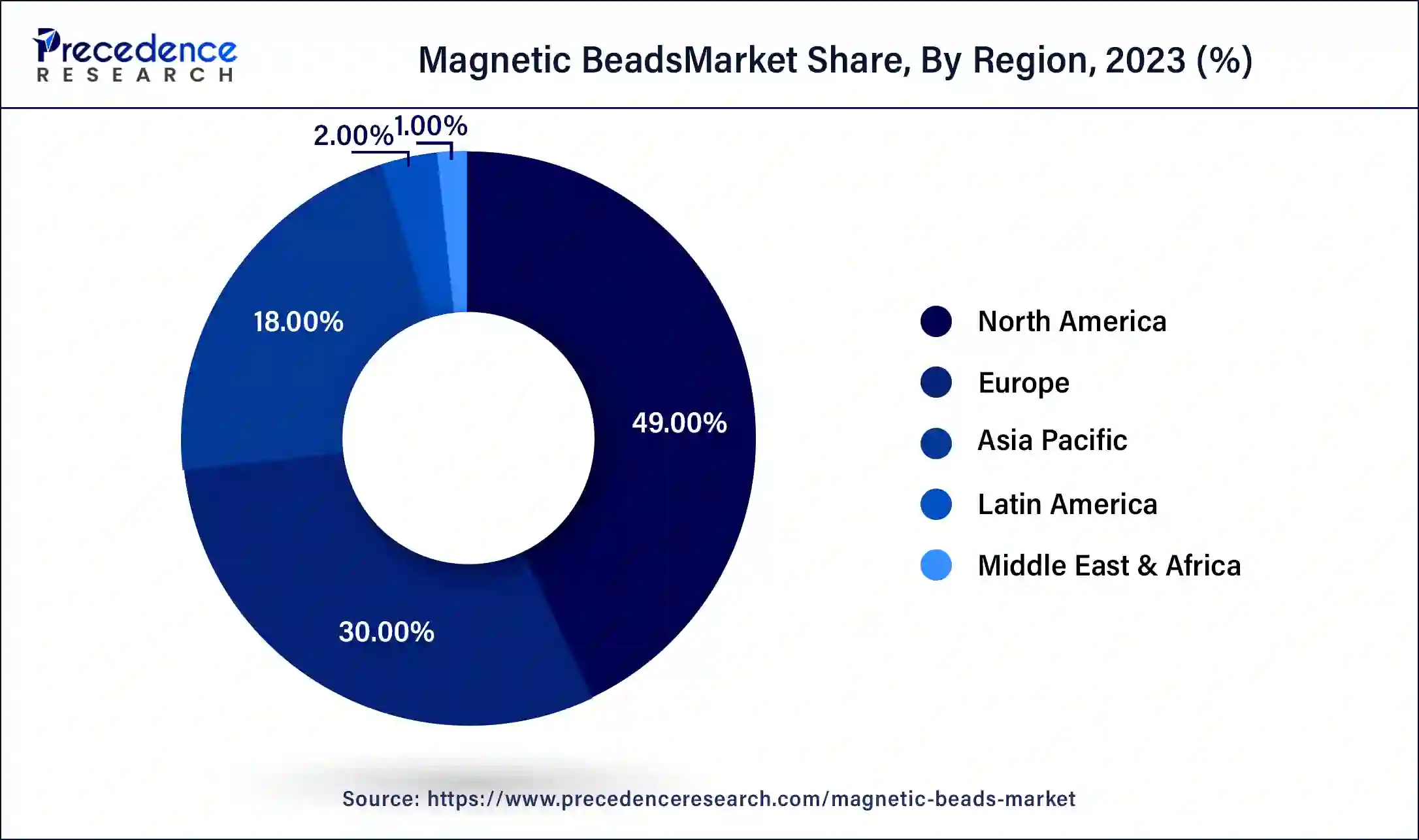January 2025
The global magnetic beads market size was USD 3.80 billion in 2023, calculated at USD 4.24 billion in 2024 and is expected to be worth around USD 12.72 billion by 2034. The market is slated to expand at 11.62% CAGR from 2024 to 2034.
The global magnetic beads market size is projected to be worth around USD 12.72 billion by 2034 from USD 4.24 billion in 2024, at a CAGR of 11.62% from 2024 to 2034. The North America magnetic beads market size reached USD 1.86 billion in 2023. In the medical field, increasing magnetic beads applications, rising investment in cell-based research by government bodies and biotechnology companies, and increasing demand for in vitro diagnostic testing are driving the market’s growth.

The U.S. magnetic beads market size was exhibited at USD 1.49 billion in 2023 and is projected to be worth around USD 5.07 billion by 2034, poised to grow at a CAGR of 11.77% from 2024 to 2034.

North America dominated the magnetic beads market in 2023. The increasing investment in nucleic acid-based and cell-based research activities is accelerating the regional growth of the market. Increasing demand for in vitro diagnostic tests, adoption rate, and high awareness of magnetic beads in research laboratories and hospitals, as well as advanced technologies across Canada and the United States, enhance the market growth in the North American region.

Asia Pacific is estimated to be the fastest-growing during the forecast period of 2024-2034. The rapid growth in diagnostics and healthcare industries in Japan and China contributed to the growth of the magnetic beads market because of supportive government regulations and policies and rising expenditure in medical companies. The rising need for advanced diagnostics technology adoption because of rising chronic diseases is driving the demand for magnetic beads in the region.
The magnetic beads market refers to buyers and sellers of iron oxide nanoparticles, such as magnetite nanoparticles (Fe3O4), with sizes of around 20nm to 30nm. These are highly used in the healthcare sector. Magnetic beads, also known as superparamagnetic particles, are one of the most versatile tools in molecular biology for effective and easy isolation of biomolecules. The magnetic beads have many benefits, including being well-suited and automation-friendly for preparing samples for next-generation sequencing (NGS) and PCR, straightforward and quick protocols, high yield, reproducible isolation of high molecular DNA, etc.
How is AI Changing the Magnetic Beads?
The use of artificial intelligence (AI) in magnetic beads technology offers many benefits, mainly in the fields of diagnostics and life sciences, which contribute to the magnetic beads market growth. The benefits of AI in magnetic beads include improved precision and efficiency; AI can help automate the processing and handling of magnetic beads, which increases consistency and reduces human errors. This is mainly useful in polymerase chain reaction (PCR) and next-generation sequencing (NGS) sample preparation. It also includes the benefits of optimized protocols, enhanced sensitivity and specificity, advanced data analysis, real-time monitoring, scalability and standardization, quality control, rapid processing, reduced hands-on time, and versatility and adaptability.
| Report Coverage | Details |
| Market Size by 2034 | USD 12.72 Billion |
| Market Size in 2023 | USD 3.80 Billion |
| Market Size in 2024 | USD 4.24 Billion |
| Market Growth Rate from 2024 to 2034 | CAGR of 11.62% |
| Largest Market | North America |
| Base Year | 2023 |
| Forecast Period | 2024 to 2034 |
| Segments Covered | Type, Application, End-use, and Regions |
| Regions Covered | North America, Europe, Asia-Pacific, Latin America and Middle East & Africa |
Increasing demand for in-vitro diagnostic testing
The increasing demand for in vitro diagnostic testing contributes to the growth of the magnetic beads market. This method is performed in vitro by coating the beads with ligands specific to the target cell or molecule type. The use of an external magnetic field to isolate molecules or cells of interest directly by positive selection or indirectly by negative selection. The benefits of in-vitro diagnostics include improved patient care and management, preventing the spread of diseases, IVD acts as the first line of defense against the spread of diseases, and early detection of diseases.
Downsides of magnetic beads
The downsides of magnetic beads include that they are not helpful for high-level research processing, that they have high costs linked with genetic research in developing countries, that they have stringent regulations, etc., which can impact the growth of the magnetic beads market. It may cause intestinal obstruction, decrease the enriched samples, damage more sensitive cell types and downstream functions, risk population integrity, decrease cell viability, may not withstand the forces of a strong magnetic field, etc.
Collaborations and partnerships
Forming strategic collaborations with research institutes and technology providers can promote advancement and product development. Collaborations may lead to the creation of innovative magnetic bead solutions that use new advancements in IoT, AI, and other technologies. Collaborations with key players in many industries may lead to the expansion of magnetic bead technology applications. The development of sustainable, advanced, and eco-friendly magnetic beads can help the magnetic beads market grow.
The cells & microbes segment dominated the magnetic beads market in 2023. The magnetic beads provide a solution that may transform the biological research field by raising the efficiency of protocols of cell isolation, enhancing bioimaging techniques, and providing alternatives for the diagnosis and treatment of tumors. These are highly used for separation of certain cells, organelle, RNA, DNA, and protein isolation, size selection, purification of genetic material, etc. The applications of magnetic beads for cells & microbes also include cell analysis, next-generation sequencing (NGS), and immunoassays.
The nucleic acid segment is anticipated to grow at the fastest rate in the magnetic beads market during the forecast period. The benefits of magnetic beads-based nucleic acid isolation include high reproducibility, high specificity, and the ability to process multiple samples at a time. The magnetic separation step reduces the need for cumbersome centrifugation steps and simplifies the process, making it high throughput applications and amenable to automation. The magnetic beads-based nucleic acid isolation depends on the use of paramagnetic coatings that bind to nucleic acids. It also includes the benefits of producing high-quality DNA, having no hazardous or toxic materials disposal issues, having no fume hood required, using non-toxic materials, using a fast and easy method, etc.
The proteins segment is expected to grow significantly during the forecast period. The magnetic beads are used to purify single proteins, large protein antibodies, complexes, and high throughput purification, which helps the growth of the magnetic beads market. The benefits of magnetic bead-based protein purification include versatility, scalability, speed, improved purity, higher yield, minimizing the risk of degradation or denaturation, easy automation, compatibility with many sample types, specific and efficient binding, and reducing the risk of non-specific interactions.
The immunoprecipitation segment is anticipated to be the fastest-growing in the magnetic beads market during the forecast period. Magnetic kit immunoprecipitation is a method used to isolate protein complexes or specific proteins. Pierce and Dynabeads magnetic beads are mainly used for this technique. The beads are mixed with conjugated antibodies and applied to a protein mixture. The antibodies bind to the target proteins, and the proteins targeted by the antibodies are captured onto the beads via the antibodies. This method allows for low antibody consumption at the time of obtaining a high yield of the target protein. The benefits of magnetic beads immunoprecipitation offer many advantages, including highly reproducible, no pre-clearing required for high protein yields, little to no non-specific binding, low background, the uniform composition of magnetic beads ensures the most consistent results, etc., contribute to the growth of the magnetic beads market.
The research labs segment dominated the magnetic beads market in 2023. The magnetic beads play an important role in the research labs. It offers various benefits, including magnetically activated cell sorting (MACS), separation of specific cells, organelle or target types, size selection, protein isolation, and purification, including DNA, RNA, plasmids, and mitochondrial DNA. There are opportunities to learn about state-of-the-art equipment in state-of-the-art laboratories, explore postgraduate pathways, make important connections, present at conferences, co-author, etc.
The healthcare facilities segment is expected to be the fastest-growing in the magnetic beads market during the forecast period. Magnetic fields have many applications in healthcare due to their unique properties. Applications of the magnetic field in healthcare include useful in pain management or pain relief; it plays a role in wound healing by promoting tissue repair and blood flow, in diagnostic techniques for separating macromolecules of nucleic acid, peptides, and proteins, purification of biomolecules, etc. contribute to the growth of the magnetic beads market.
Segments Covered in the Report
By Type
By Application
By End-use
By Geography
For inquiries regarding discounts, bulk purchases, or customization requests, please contact us at sales@precedenceresearch.com
No cookie-cutter, only authentic analysis – take the 1st step to become a Precedence Research client
January 2025